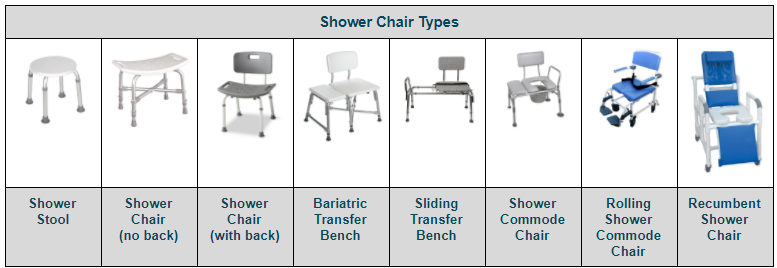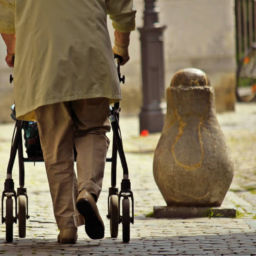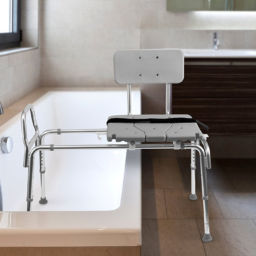![How to Choose the Best Bath Chair or Transfer Bench [Buying Guide]](https://hallofcare.com/wp-content/uploads/2019/04/Gartner_Bath_Bench-thegem-blog-default.jpg)
Do you or a loved one struggle with mobility, stability and illness issues that prevent you from standing and washing safely in your tub or shower? Did you know a bath or shower chair, bench or stool might be the best solution to allow you to safely bathe while fostering your independence? Let’s look how to choose the best bath chair or transfer bench [Buying Guide].
Bathing Support Solutions
Bath chairs, benches and stools can be a safe and effective means of aiding with your personal hygiene not to mention maintaining your level of independence. Do you know which support option is right for you?
- Shower stools – armless and backless round seating solution generally made for smaller bathing areas. They are available in styles to fit nearly all sizes of people (standard to bariatric).
- Shower chair (no back) – armless and backless seating solution that is usually rectangular in shape with smoother sides to fit most bathing areas. They are available in styles to fit nearly all sizes of people (standard to bariatric).
- Shower chair (with back) – can be armless but provided with back support to provide extra stability during sitting, rising and bathing activities. Some chairs have the option to remove the back piece. They are available in styles to fit nearly all sizes of people (standard to bariatric).
- Transfer bench – designed to sit partially outside the tub for those needing assistance sitting outside the tub and sliding over into the washing area. They are heavier than stools and would like be a more permanent solution in your tub or shower. They are available in styles to fit nearly all sizes of people (standard to bariatric).
- Sliding transfer bench – same concept as the transfer bench except the person does not have to scoot over in the seat. A release mechanism allows the person to slide over in a seated position. They are available in styles to fit nearly all sizes of people (standard to bariatric).
- Shower commode chair – designed for ambulatory people who need toilet support in the shower. It can also serve as easier access to washing lower areas with an opening in the seating area.
- Rolling shower commode chair – designed for those not ambulatory and can be wheeled directly into and out of the shower. The chair is waterproof with toileting capabilities. Caregivers can easily work around patient meeting their personal hygiene needs.
- Recumbent shower chair – designed for those not ambulatory and who may not be able to sit up on their own. It can be wheeled directly into and out of the shower. The chair is waterproof with toileting capabilities. Caregivers can easily work around patient meeting their personal hygiene needs.
Bath Chair and Transfer Bench Reviews
Do you know already which chair or bench you need? You can skip to our in-depth reviews at:
- Top 5 Best Bariatric Bath Transfer Benches 2019
- Top 5 Best Bariatric Bath Chairs 2019
- Top Best Standard Bath Transfer Benches 2019
- Top Best Standard Bath Chairs 2019
If you are still not sure which one is right for you please continue reading. Answering these vital questions will help narrow your choices to right solution for your needs.
How to choose the best bath chair or transfer bench [Buying Guide]
There are several factors you need to consider to find the right bath chair or bench for you or your loved one. Here are our top 10 selection criteria to aid in your decision.
#1
Can you safely enter, exit and wash yourself in your existing tub or shower if you had a seated solution?
Many people can effectively wash all parts of themselves with relative ease but just can’t stand during the shower duration. This could be due to knee pain, back pain, recent surgery, general leg or arm strength, hip problems, a medical condition or the size of your body. If you answered “no” to any part of the question then a shower chair or bench may be a great solution for you.
#2
Do you need the assistance of a caregiver or family member?
Some people may be able to wash parts of themselves, but may lack the mobility or agility to wash the harder to reach areas. This may require assistance from another person, such as a family member or caregiver. You will need to make sure your seating solution allows room for that person to move around you to help complete your bathing. Depending on the severity of your situation you may need a full roll-in shower wheelchair, wheelchair and commode combo, a recumbent chair or perhaps even a lift to move you in and out of the shower area with assistance.
#3
Will you need to move your seating solution in and out of the tub or shower to accommodate others?
This can become a problem if you or other family members (or caregiver) are too weak to move your chosen solution out of the tub or shower. Ideally it would be great if you could put your solution in place and not need to move it again. Bath transfer benches are great for people sitting on the outside of the tub to be able to slowly move their legs and body across the bench into the tub. However, they are large and heavy if you had to keep moving it in and out of your tub. The same issue may apply to smaller showers too. There are smaller lighter shower chairs, folding chairs and even pull-down benches that can be easily installed allowing for them to be easily tucked out of the way when not needed.
#4
Is your current tub or shower suitable for a bath seating solution?
Many homes have older bathtubs that are concave, meaning they have rounded sides and a smaller flatter bottom. The legs on some seating solutions may not sit flat inside your tub. This may be an accident waiting to happen! Make sure you measure the flat area of the tub (or shower) and the distance between the feet (not the legs as they can be smaller) on the bath seat to make sure it will solidly sit on your floor. Many seating solutions use angled legs in their frames and do not necessarily give you the dimension between the chair feet only the upper part of the leg frame. The suction cups on the feet of your seat need to firmly grip your tub or shower floor to avoid the seat sliding or flipping while getting up or sitting down.
#5
Is your lower body wider than an average chair or is your weight an issue purchasing furniture?
If your lower body is larger than the top half you may need a chair or bench with an optional back to safely and comfortably accommodate your bathing needs. If you are larger person (bariatric) you will not only need to consider your seating safety and comfort but, choose a seat that can accommodate more than your current weight. Seats that use cross-bracing on the legs are specifically made for the heavier user and will usually support higher weight limits. There are many bath seating solutions for larger size (bariatric) people. Make sure you choose one that fits your needs.
Generally standard bath transfer seats, chairs and stools support people up to about 300 pounds. Bariatric bath seats start around 400 pounds and can go up to 1,000 pounds.
#6
Can you sit on a bath seat but need assistance getting into the tub or shower?
Whether you are a larger size (bariatric) or normal sized person there are seating solutions called transfer benches, some having movable bench seats. You position your body on the bench outside the tub, swivel your body around parallel with the tub, lift your legs into the tub and slide yourself along the seat inward to the tub to start your bathing. Some have locks or belts to keep people from sliding off the seat when in motion. They are a good solution for those who cannot readily slide or scoot into position or may be transferring from a walker to a seated position.
#7
What if a regular bath chair, stool or bench won’t work for me?
Some people have very limited or no mobility yet still need to be bathed. If getting to a toilet is too difficult or impossible a caregiver may choose to employ a commode shower chair. This is a sturdy waterproof chair with an attached commode pan that can be wheeled in and out of the shower. This reduces the stress on a patient by accomplishing two tasks in one. Commode shower chairs come in regular and bariatric sizes.
There are also recumbent (reclining) chairs for patients who either cannot sit upright or need a caregiver to provide most of the bathing activities. For immobile or nearly immobile patients there are manual and electric sling options (hoyers) for moving patients in and out of a shower or custom tub area.
#8
Are there other options than removable chairs, stools or benches?
Yes, there are shower or tub mounted benches that be folded up when not in use. This can be an easier and more elegant solution to removable products. However, it may not be feasible to drill the seat anchors into existing shower or tub walls. You certainly would want to evaluate this solution in a new or remodeled bathroom situation.
#9
What construction material is best?
This largely depends on who is using the seating. Smaller more mobile patients may be just fine with plastic and PVC pipe solutions. These are more desirable as they are lighter and can be easily moved in and out of the tub or shower. For larger or less stable patients an aluminum frame would be more desired. It may also depend on if backrests or handrails are needed. Heavier aluminum chairs and benches will cost more but it may be necessary to ensure the safety and stability of your bathing solution.
#10
Are there any other considerations when making a seating decision?
You will want to make sure whatever solution being considered meets ADA guidelines for accommodating the physically disabled. Review product information carefully to ensure the bath solution meets the stresses of safely supporting body weight in a wet environment.
There are options of a padded versus a thick hard plastic seat. This can be a concern for people who have sensitive skin that may be prone to rips or tears. Some seating solutions have height adjustable legs and reversible backrests and handrails.
There are also purchasing options to consider. Many of these seating solutions are not generally covered by medical insurance, Medicare or Medicaid and may require an out of pocket purchase. You should check with your doctor or durable medical equipment (DME) department to see if any of your desired solutions are covered prior to committing to a purchase.
The bottom line for How to choose the best bath chair or transfer bench [Buying Guide]…
As mentioned above there are a plethora of chairs, benches and stools to choose from for your bathing needs. The worst thing you can do is not spend the time to evaluate your personal needs and comforts along with the tub or shower situation where you need to use it.
Do not force a chair or bench to fit in your space. Do not alter the chair or bench to fit the space either. Not only will it void the manufacturer’s warranty, but it may create an unsafe seating solution.
If you are a larger person don’t choose a small stool even if it is rated at your weight. You should not purchase a seating solution when you are very near or at the stated weight limit of the chair. You need to account for shifts in your weight and body as you shower. It’s your bath time. Make sure you are safe and comfortable with your choice!
In the long run a good bath seat can:
- save you a ton of money by reducing falls and trips in and out of the tub or shower resulting in hospital visits;
- allow your caregivers a safer and easier way to help you bathe,
- give your loved ones peace of mind knowing you have a safe, reliable and easy to use solution for accomplishing your routine tasks, and
- further elevate your level of dependence.
We sincerely hope how to choose the best bath chair or transfer bench [Buying Guide] has provided essential information for choosing your next bath seating solution.
Bath Chairs and Benches for Standard and Bariatric Use
Here are some good choices of standard and bariatric bath chairs and transfer benches. You can also read our in-depth reviews to find out the pros and cons of each chair or bench:
- Top 5 Best Bariatric Bath Transfer Benches 2019
- Top 5 Best Bariatric Bath Chairs 2019
- Top Best Standard Bath Transfer Benches 2019
- Top Best Standard Bath Chairs 2019
Standard bath chairs and benches usually support weights up to 300 pounds. Most fit standard size showers and bathtubs. Always measure your space, noting any lips or concave areas, before deciding on a seated solution.
Standard Bath Benches:
Standard Bath Chairs:
Bariatric bath chairs and benches usually support weights over 300 pounds. Many bariatric chairs and transfer benches will fit modern size showers and bathtubs. Always measure your space, noting any lips or concave areas, before deciding on a seated solution. This is especially important for the larger bariatric chairs and benches.
Bariatric Bath Benches:
Bariatric Bath Chairs:
Bath and Shower Chair Selection and Use Video Instruction
Here are two videos on understanding differences between bath chairs and how to properly use a bath transfer seat.
Personal Connection
 My wife reached a point in her condition where she could no longer climb in and out of our tub nor use the tiny shower in our master bathroom to wash. She was forced to sponge bathe from the bathroom sink sitting on a stool for well over a year until we could redesign our master bathroom for her needs.
My wife reached a point in her condition where she could no longer climb in and out of our tub nor use the tiny shower in our master bathroom to wash. She was forced to sponge bathe from the bathroom sink sitting on a stool for well over a year until we could redesign our master bathroom for her needs.
My wife is bariatric (plus sized) with the lower half of her body larger than her upper half. The severe case of Lipedema and Lymphedema in her lower body required careful consideration of bathroom layout and products to help her be as independent as possible. She chose to use a bariatric transfer bench for our shower so it was wide enough to comfortably sit and move around during bathing. It is rated about 100 pounds more than her size and is made with cross-bars on the leg frame for extra stability for larger persons. She chose not to use the back piece to make it easier to wash her back (or me on days she is not feeling well), but relies on the handrail for rising and sitting down. She also relies on two large grab bars for moving in and out of the shower as well as shower mount at chest level so she can easily manipulate the shower-head.
If you are interested in knowing what works for her as a shower solution, here is her product set:
Medline Bariatric transfer bench
Moen Nickel grab bars (18″ and 36″)
Delta shower mount (mounted at chest height in shower for wife with original mount on top for me)
Command strips to hold long handled bath brush and bath scrub
We would love to hear how a bath chair or bench has helped you remain independent in your home or if you have any questions about finding the right bathing solution for your needs. Drop us a line below in the comments section or send us a private note using our contact form.
To Your Improved Health!





































My dad is coming to visit me for Christmas. He was in intensive care for 3 months and lost a LOT of weight, and of course has gotten very weak. I need to find a solution for my bathtub, so that he is safe getting in and out, and then taking his shower. These chairs are something I have been considering. I don’t want him slipping and falling. I do have one question. What do I have for him to get into the tub? I want him to safely and comfortably get in and out of the tub. Which chair would you recommend for the regular size bath tub? Thanks!
If you could let me know the width of the flat surface of your tub I can see which product would fit your tub safely for him to enter and exit. Can he lift his legs over the tub to get in and sit or does he need to sit outside the tub and then slide in? This would be the difference between a bath chair or a transfer bench. Can he pivot to align himself parallel to the tub? Does he have the strength to slide over the tub edge to the inside seat or would he need assistance moving? We have benches that have a sliding seat for people who cannot slide. I would also need to know his approximate weight so we can make sure he the seat can safely support him. You can email me at info@hallofcare.com directly with the specifics if you feel more comfortable sharing that way. Thanks for letting us help you!
My grandfather has been looking into purchasing a shower chair. I am glad that your article mentions that one of the things to consider is sharing the bathroom with others, as he lives with us. I’ll look into what options are available to determine which would be best for my grandpa.